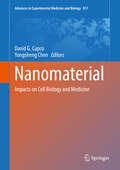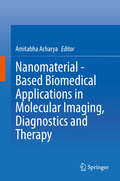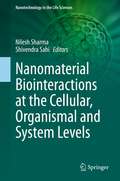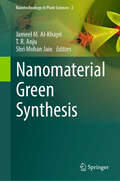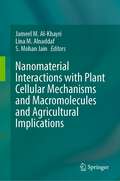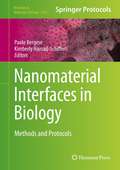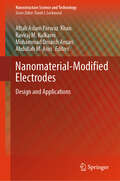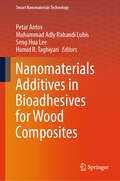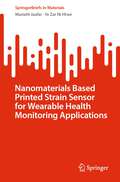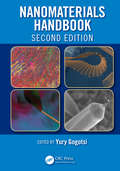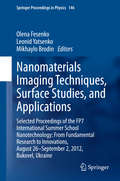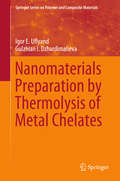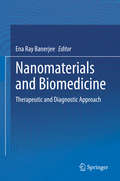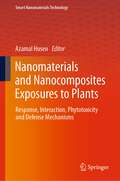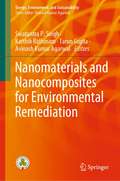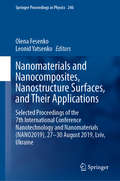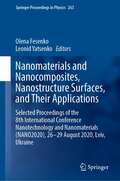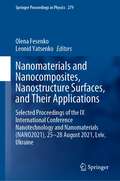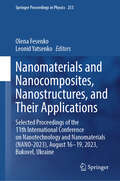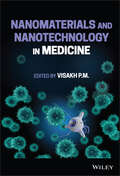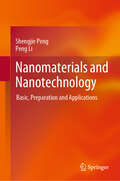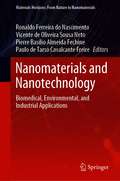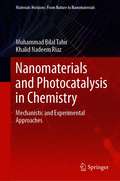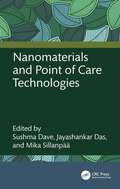- Table View
- List View
Nanomaterial
by David G. Capco Yongsheng ChenThe rapidly developing field of nanomaterials has expanded in many commercial areas. More recent studies have begun to provide a foundation for understanding how nanomaterials influence cells and how they also can serve as methodological tools for studies in medicine and cell biology, including research into stem cells. Recent investigations have shown affects of nanomaterials on specific subcellular structures, such as the actin-based brush border network in cells with an increasing emphasis on the barrier function of epithelial tissues. While other studies have shown involvement of nanoparticles in specific cytoplasmic signal transduction events such as the rise in intracellular free calcium, a signaling event known to regulate many changes in cell architecture and function. In parallel, nanomaterials are increasingly used in medicine for drug delivery, treatment of cancer and an increasing number of new applications. This book investigates these areas and also includes new methods for assessment in cell biology and medicine.
Nanomaterial - Based Biomedical Applications in Molecular Imaging, Diagnostics and Therapy
by Amitabha AcharyaThis book comprehensively reviews the recent advances in nanomaterial-based molecular imaging, diagnostics, and personalized therapy. It discusses the novel biocompatible fluorescent nanomaterials, their synthesis, and modern state of art characterization, as well as the various strategies for immobilization of biomacromolecules on the nanomaterial surface and approaches for increasing their stability. In addition, the book describes the synthesis of lectin nanoconjugates using different types of biocompatible raw materials and their systematic characterization. Lastly, it presents our current understanding of the biomolecular carona, which affects nanoparticle-based targeted drug delivery, and examines the conceptual approaches to improve the in-vivo efficacy of targeted drug delivery.
Nanomaterial Biointeractions at the Cellular, Organismal and System Levels (Nanotechnology in the Life Sciences)
by Nilesh Sharma Shivendra SahiThe range of nanomaterial applications has expanded recently from catalysis, electronics, and filtration to therapeutics, diagnostics, agriculture, and food because of unique properties and potentials of different nanoparticles and nanomaterials. Research shows that these exquisite particles can interact with an organism at the cellular, physiological, biochemical, and molecular levels. However, our knowledge of how they affect these changes, selectively or generally, in diverse organism or ecosystems is very limited and far from satisfactory. Data indicate that the biological function largely depends on the shape, size, and surface characteristics of the nanoparticles used besides life cycle stages of an organism. Therefore, this compilation will focus on the body of work carried out by distinguished investigators using diverse nanomaterials and plant and animal species. This book includes specific case studies as well as general review articles highlighting aspects of multilayered interactions, and targets not only research and academic scholars but also the concerned industry and policy makers as well.
Nanomaterial Green Synthesis (Nanotechnology in Plant Sciences #2)
by Shri Mohan Jain Jameel M. Al-Khayri T. R. AnjuThis book discusses the convergence between nanotechnology and sustainability detailing the advances in addressing global challenges in achieving technological advancement in nanoscience. It delves into eco-friendly advancements in agricultural nanotechnology, highlighting the transformative potential and challenges. The core of the book emphasizes green chemistry approaches, detailing the biological routes for synthesizing nanomaterials, alongside non-biological methods that minimize environmental impact. It investigates the biocompatibility of green nanomaterials for safer applications and assesses their recyclability and reusability. Chapters on life cycle assessment provide insights into the environmental footprints of nanomaterials. The book contrasts top-down and bottom-up approaches while comparing chemical and green synthesis. Special attention is given to nanomaterials derived from lignocellulosic biomass, underlining the role of waste valorization. In addition, it offers a critical analysis of challenges and perspectives in green nanotechnology, setting a roadmap for sustainable advancements. The book consists of 18 chapters that explore various aspects of green synthesis of nanomaterials. Chapters are contributed by 64 recognized scientists from 7 countries and subjected to a rigorous review process to ensure quality presentation and scientific precision. Chapters begin with an introduction providing background followed by a detailed discussion of the topic accompanied by 129 high-quality color figures and 24 tables. Each chapter concludes with recommendations for future study directions. The book is an excellent reference source for graduate students engaged in nanotechnology and for professional researchers working on translational research on nanomaterial biological and physiochemical aspects.
Nanomaterial Interactions with Plant Cellular Mechanisms and Macromolecules and Agricultural Implications
by S. Mohan Jain Jameel M. Al-Khayri Lina M. AlnaddafThis book focuses on the recent progress of nanotechnology with emphasis on the interaction between nanoparticles and plants on the cellular level. It is devoted to understanding the pathways of nanomaterials entry into plant cell and their influence on cellular organelle processes and influence on crop yield. It consists of 16 chapters grouped in 3 parts: Part I Cellular mechanisms, Part II Cellular macromolecules, and Part III Implications of nanomaterials. Chapters present the plant response to nanomaterial applications including morphological, physiochemical, and anatomical changes and their effect on plant growth and productivity. The book discusses the mechanisms of absorbance and translocation of nanoparticles and their interaction with the plant cellular biochemical compounds and organelles. It presents the current perspective of nanomaterials influence on cellular processes which include photosynthesis, photorespiration and pigment synthesis and accumulation. In addition, it provides current understanding of the impact of nanomaterials on cellular macromolecules including carbohydrates, lipids, nucleic acids, proteins, hormones, and antioxidant defense activities. Collectively, these processes and biochemical compounds have implications on crop yield. Chapters are written by globally recognized scientists and subjected to a rigorous review process to ensure quality presentation and scientific precision. Chapter begins with an introduction that covers similar contexts and includes a detailed discussion of the topic accompanied by high-quality color images, diagrams, and relevant details and concludes with recommendations for future study directions.Chapter "Impact of Nanomaterials on Plant Secondary Metabolism" is available open access under a Creative Commons Attribution 4.0 International License via link.springer.com.
Nanomaterial Interfaces in Biology: Methods and Protocols
by Kimberly Hamad-Schifferli Paolo BergeseThe intersection of nanotechnology with biology has given rise to numerous ideas for new ways to use nanotechnology for biological applications. Nanomaterials possess unique size- and material-dependent properties which make them attractive for improving regular biomedical fields, such as drug delivery, imaging, therapy, and diagnostics. Divided into three convenient sections, Nanomaterial Interfaces in Biology: Methods and Protocols covers protocols describing synthesis, fabrication, and construction of bio-nanomaterial interfaces, characterization protocols of bio-nanomaterial interfaces, and applications which utilize the bio-nanomaterial interfaces. Written in the highly successful Methods in Molecular Biology series format, chapters contain introductions to their respective topics, lists of the necessary materials and reagents, step-by-step, readily reproducible laboratory protocols, and notes on troubleshooting and avoiding known pitfalls. Authoritative and accessible Nanomaterial Interfaces in Biology: Methods and Protocols will serve the new and emerging scientific community, enabling new capabilities and technologies that were not previously possible in medicine and biology.
Nanomaterial-Modified Electrodes: Design and Applications (Nanostructure Science and Technology)
by Abdullah M. Asiri Mohammad Omaish Ansari Aftab Aslam Parwaz Khan Raviraj M. KulkarniThis contributed volume overviews the latest developments in the area of nanomaterial-modified electrodes and presents their unique biosensing, pharmaceutical and environmental applications. The book provides a comprehensive introduction on the basics of electrochemical sensors while also presenting overviews of multiple modified electrodes as essential elements for the development of sensors. The principle electrochemical sensors which are transducing the chemical/biochemical reactions to electrical signals are presented, while a special focus on lab-on-chips as well as the design and applications of various flexible electrodes is given. This book is of great benefit to researchers, graduate students and professionals working in the areas of biosensing, materials science, environmental engineering and pharmaceutical analysis.
Nanomaterials Additives in Bioadhesives for Wood Composites (Smart Nanomaterials Technology)
by Hamid R. Taghiyari Seng Hua Lee Petar Antov Muhammad Adly Rahandi LubisThis book presents an overview of recent developments in the use of nanomaterials, such as nanocellulose, nanolignin, and nanoclay, in the synthesis of sustainable, bio-based adhesives for manufacturing high-performance, eco-friendly wood-based composites with enhanced properties, close-to-zero formaldehyde emission, and a lower environmental footprint for advanced value-added applications. In recent years, bio-based wood adhesives have received great attention as a sustainable alternative to the conventional synthetic adhesives used in the wood-based industry. However, bioadhesives based on natural and renewable feedstocks, such as protein, starch, lignin, and tannin, have inferior properties compared to thermosetting synthetic resins. Reinforcement with nanomaterials with a high aspect ratio has the potential to improve the performance of bio-based wood adhesives and the technological properties of wood composites. The book explores the present-day challenges and future prospects of using nanomaterials in bio-based wood adhesives. The content of this book appeals to materials scientists, wood scientists, environmental scientists, and wood-based panel industry professionals.
Nanomaterials Based Printed Strain Sensor for Wearable Health Monitoring Applications (SpringerBriefs in Materials)
by Mariatti Jaafar Ye Zar Ni HtweThis book reviews different types of nanomaterials-based-conductive inks used to develop printed strain sensors, printing fabrication methods, and applications such as wearable health monitoring. Printed wearable electronic devices have recently drawn a lot of attention, as shown by the increasing number of publications and commercialized devices covering various facets in emerging fields. Many researchers are working toward optimizing nanoparticle-based-conductive inks for wearable electronics. However, issues related to its stability, dispersion, and annealing temperature often limit its applications. General important information and requirements of flexible electronics for health monitoring are covered in the book chapter. The target audiences are researchers and students who are involved in the development of printed wearable electronics.
Nanomaterials Handbook (Advanced Materials and Technologies)
by Yury GogotsiThis title features 11 new chapters unique to this edition, including chapters on grain boundaries in graphene, 2D metal carbides and carbonitrides, mechanics of carbon nanotubes and nanomaterials, biomedical applications, oxidation and purification of carbon nanostructures, sintering of nanoceramics, hydrothermal processing, nanofibers, and nanomaterials safety. It offers a comprehensive approach with a focus on inorganic and carbon-based nanomaterials, including fundamentals, applications, synthesis, and characterization. This book also provides a unique angle from the nanomaterial point of view on application, synthesis, and characterization not found in any other nanomaterials book on the market.
Nanomaterials Imaging Techniques, Surface Studies, and Applications: From Fundamental Research to Innovations, August 26-September 2, 2012, Bukovel, Ukraine
by Leonid Yatsenko Mikhaylo Brodin Olena FesenkoThis book presents cutting-edge research on a wide range of nanotechnology techniques and applications. It features contributions from scientists who participated in the International Summer School "Nanotechnology: From Fundamental Research to Innovations" in Bukovel, Ukraine on August 26 - September 2, 2012 funded by the European Commission FP7 project Nanotwinning implemented by the Institute of Physics of National Academy of Sciences of Ukraine and partner institutions: University of Tartu (Estonia), European Profiles A.E. (Greece), University of Turin (Italy) and Université Pierre et Marie Curie (France). Worldwide experts present the latest results on such key topics as microscopy of nanostructures; nanocomposites; nanostructured interfaces and surfaces; nanooptics; nanoplasmonics; and enhanced vibrational spectroscopy. Imaging technique coverage ranges from atomic force microscopy and spectroscopy, multiphoton imagery, and laser diagnostics of nanomaterials and nanostructures, to resonance Raman and SERS for surface characterization, and scanning tunneling microscopy of organic molecules. The breadth of topics highlights the exciting variety of research currently being undertaken in this field and suggests new opportunities for interdisciplinary collaboration and future research.
Nanomaterials Preparation by Thermolysis of Metal Chelates (Springer Series on Polymer and Composite Materials)
by Gulzhian I. Dzhardimalieva Igor E. UflyandThe book focuses on the thermal transformations of various types of metal chelates, e.g. low molecular weight and polymeric metal chelates, coordination polymers and metal-organic frameworks. It analyzes the major advances and the problems in the preparation of metal oxide materials, mixed-oxide nanocomposites, carbon materials and polymer derived non-oxide nanocomposites by the thermolysis of different metal chelates. It also highlights the influence of the spatial and electronic structure of metal chelates on the mechanism and kinetics of their thermal transformations, and discusses important issues like conjugate thermolysis and computer modelling of the thermolysis process. This book is useful for researchers experienced in thermolysis as well as for young scientists interested in this area of science.
Nanomaterials and Biomedicine: Therapeutic and Diagnostic Approach
by Ena Ray BanerjeeThis book comprehensively reviews the history of nanotechnology, and describes the physiochemical properties of various nanoparticles and their biomedical applications. Covering the biotoxicity of nanoparticles, their bio-distribution and release kinetics, and their role in diagnosis, pre-clinical drug discovery and disease prevention, it also examines the application of nanoscaffolds in tissue engineering and as cell culture templates. Further, the book discusses several fabrication methodologies for regenerative medicine, and explores nanotechnology-based stem cell therapeutics, including stem cell transfection, stem cell delivery, and stem cell expansion for promoting tissue regeneration. Lastly, it addresses the use of DNA barcoding technology from nanosamples for the detection, identification and validation of emerging pathogens, biodiversity and ancient remnants of living specimens, and highlights various strategies for the plant-mediated synthesis of nanoparticles. Given its scope, it is a valuable reference resource for graduate students and researchers interested in understanding the diverse range of biomedical applications of nanoparticles.
Nanomaterials and Environmental Biotechnology (Nanotechnology in the Life Sciences)
by Vivek Kumar Singh Durgesh Kumar Tripathi Indu BhushanNanotechnology is considered as one of the emerging fields of science. It has applications in different biological and technological fields which deal with the science of materials at nanoscale (10-9). On the other hand, biotechnology is another field that deals with contemporary challenges. Nanobiotechnology fills the gap between these two fields. It merges physical, chemical, and biological principles in a single realm. This combination opens up new possibilities. At nanoscale dimensions, it creates precise nanocrystals and nanoshells. Integrated nanomaterials are used with modified surface layers for compatibility with living systems, improved dissolution in water, or biorecognition leading to enhanced end results in biotechnological systems. These nanoparticles can also be hybridized with additional biocompatible substances in order to amend their qualities to inculcate novel utilities. Nanobiotechnology is used in bioconjugate chemistry by coalescing up the functionality of non-organically obtained molecular components and biological molecules in order to veil the immunogenic moieties for targeted drug delivery, bioimaging and biosensing. This book blends the science of biology, medicine, bioinorganic chemistry, bioorganic chemistry, material and physical sciences, biomedical engineering, electrical, mechanical, and chemical science to present a comprehensive range of advancements. The development of nano-based materials has made for a greater understanding of their characterization, using techniques such as transmission electron microscope, FTIR, X-ray diffraction, scanning electron microscope EDX, and so on. This volume also highlights uses in environmental remediation, environmental biosensors and environmental protection. It also emphasizes the significance of nanobiotechnology to a series of medical applications viz., diagnostics, and therapeutics stem cell technology, tissue engineering enzyme engineering, drug development and delivery. In addition this book also offers a distinctive understanding of nanobiotechnology from researchers and educators and gives a comprehensive facility for future developments and current applications of nanobiotechnology.
Nanomaterials and Nanocomposites Exposures to Plants: Response, Interaction, Phytotoxicity and Defense Mechanisms (Smart Nanomaterials Technology)
by Azamal HusenThis book looks at the interaction between plants and nanomaterials/nanocomposites, and their effects ecology, the food chain and human health. It focuses on nanomaterials/nanocomposites phytotoxicity, which is an important precondition to promote the application of nanotechnology and to avoid the potential ecological risks. It describes the influencing factors of nanotoxicity of nanomaterials and the mechanisms of these toxic effects and defense mechanisms in plants. The chapters in this book are written by internationally renowned researchers and professionals and provides exciting and remarkable information (on the above-mentioned topics) to the scientist, researcher and student working field of plant biology, agricultural science, nanobiotechnology, plant biochemistry, plant physiology, plant biotechnology and many other interdisciplinary subjects.
Nanomaterials and Nanocomposites for Environmental Remediation (Energy, Environment, and Sustainability)
by Avinash Kumar Agarwal Tarun Gupta Swatantra P. Singh Karthik RathinamThis monograph focuses on recent development of nanomaterials and nanocomposites for pollution measurement and their control in water, air, and soil. The contents incorporate carbon-based, metal-based, and metal-organic framework based nanomaterials and nanocomposites for emerging contaminants (pharmaceuticals and personal care products) degradation, disinfection, and other traditional pollutants degradation and removal. The book also offers updated literature for researchers and academicians working in the field of environmental remediation by nanomaterials. Readers will learn about different metal and non-metal based nanoparticles for environmental remediation. It will be a useful guide for professionals, and post-graduate students involved in material science & engineering, chemical engineering and environmental nanotechnology research.^
Nanomaterials and Nanocomposites, Nanostructure Surfaces, and Their Applications: Selected Proceedings of the 7th International Conference Nanotechnology and Nanomaterials (NANO2019), 27 – 30 August 2019, Lviv, Ukraine (Springer Proceedings in Physics #246)
by Leonid Yatsenko Olena FesenkoThis book highlights some of the latest advances in nanotechnology and nanomaterials from leading researchers in Ukraine, Europe and beyond. It features contributions presented at the 7th International Science and Practice Conference Nanotechnology and Nanomaterials (NANO2019), which was held on August 27–30, 2019 at Lviv Polytechnic National University, and was jointly organized by the Institute of Physics of the National Academy of Sciences of Ukraine, University of Tartu (Estonia), University of Turin (Italy), and Pierre and Marie Curie University (France). Internationally recognized experts from a wide range of universities and research institutions share their knowledge and key findings on material properties, behavior, and synthesis. This book’s companion volume also addresses topics such as nano-optics, energy storage, and biomedical applications.
Nanomaterials and Nanocomposites, Nanostructure Surfaces, and Their Applications: Selected Proceedings of the 8th International Conference Nanotechnology and Nanomaterials (NANO2020), 26–29 August 2020, Lviv, Ukraine (Springer Proceedings in Physics #263)
by Leonid Yatsenko Olena FesenkoThis book highlights some of the latest advances in nanotechnology and nanomaterials from leading researchers in Ukraine, Europe and beyond. It features contributions presented at the 8th International Science and Practice Conference Nanotechnology and Nanomaterials (NANO2020), which was held on August 26–29, 2020 at Lviv Polytechnic National University, and was jointly organized by the Institute of Physics of the National Academy of Sciences of Ukraine, University of Tartu (Estonia), University of Turin (Italy), and Pierre and Marie Curie University (France). Internationally recognized experts from a wide range of universities and research institutions share their knowledge and key findings on material properties, behavior, and synthesis. This book’s companion volume also addresses topics such as nano-optics, energy storage, and biomedical applications.
Nanomaterials and Nanocomposites, Nanostructure Surfaces, and Their Applications: Selected Proceedings of the IX International Conference Nanotechnology and Nanomaterials (NANO2021), 25–28 August 2021, Lviv, Ukraine (Springer Proceedings in Physics #279)
by Leonid Yatsenko Olena FesenkoThis book highlights some of the latest advances in nanotechnology and nanomaterials from leading researchers in Ukraine, Europe and beyond. It features contributions presented at the 8th International Science and Practice Conference Nanotechnology and Nanomaterials (NANO2020), which was held on August 25–28, 2021 at Lviv Polytechnic National University, and was jointly organized by the Institute of Physics, the National Academy of Sciences of Ukraine, Lviv Polytechnic National University, University of Tartu (Estonia), University of Turin (Italy), Pierre and Marie Curie University (France), European Profiles S.A. (Greece), Representation of the Polish Academy of Sciences in Kyiv, University of Angers (France), Ruprecht Karl University of Heidelberg (Germany). Internationally recognized experts from a wide range of universities and research institutions share their knowledge and key findings on material properties, behavior, and synthesis. This book’s companion volume also addresses topics such as nano-optics, energy storage, and biomedical applications.
Nanomaterials and Nanocomposites, Nanostructures, and Their Applications: Selected Proceedings of the 11th International Conference on Nanotechnology and Nanomaterials (NANO-2023), August 16-19, 2023, Bukovel, Ukraine (Springer Proceedings in Physics #253)
by Leonid Yatsenko Olena FesenkoThis book highlights some of the latest advances in nanotechnology and nanomaterials from leading researchers in Ukraine, Europe and beyond. It features contributions presented at the 11th International Conference on Nanotechnologies and Nanomaterials, and was jointly organized by the Institute of Physics of the National Academy of Sciences of Ukraine, University of Tartu (Estonia), University of Turin (Italy), and Pierre and Marie Curie University (France). Internationally recognized experts from a wide range of universities and research institutions share their knowledge and key findings on material properties, behavior, synthesis and their applications. The book will be interesting for leading scientists, advanced undergraduate and graduate students in material and nanoscience. This book’s companion volume also addresses topics such as nano-optics, nanoelectronics, energy storage and nanochemistry applications.
Nanomaterials and Nanotechnology in Medicine
by Dr P. M. VisakhNANOMATERIALS AND NANOTECHNOLOGY IN MEDICINE A comprehensive introduction to nanomaterials and their application in the field of medicine The use of nanotechnology and nanomaterials more generally is an emerging field that has generated a lot of interest in the last few years. To this point, there have been few books that deal with the recent advances in nanomaterials or nanocomposites in the medical discipline. Intended as a one-stop reference, Nanomaterials and Nanotechnology in Medicine provides the reader with the most-up-to-date and comprehensive exploration of the field of nanomedicine. The scope of the topic is huge, with nano applications in every medical specialization—from diagnostics to pharmaceuticals, from biological therapies to surgical devices, and from regenerative therapies to gene therapy. As such, this volume provides the most comprehensive coverage of this intriguing field of study. Nanomaterials and Nanotechnology in Medicine readers will also find: An application-oriented book dedicated towards helping researchers find solutions to both fundamental and applied problems Chapters written by leading researchers from industry, academy, government, and private research institutions across the globe Nanomaterials and Nanotechnology in Medicine is a useful reference for medical doctors, medical practitioners, post-doctoral research fellows, senior graduate students, and medical libraries.
Nanomaterials and Nanotechnology: Basic, Preparation and Applications
by Peng Li Shengjie PengThis book first systematically introduces the development history, research content, and development trend of nanomaterials and then describes the preparation methods, characterization methods, physical and chemical properties, and mechanical properties of nanomaterials, so that students can have an overall understanding and understanding of nanomaterials. On this basis, the application of nanomaterials and carbon nanomaterials which are widely studied at present is taught. Finally, the latest research progress of nanomaterials is introduced. The book lists some practical examples as far as possible to make students easy to understand and master.
Nanomaterials and Nanotechnology: Biomedical, Environmental, and Industrial Applications (Materials Horizons: From Nature to Nanomaterials)
by Ronaldo Ferreira do Nascimento Vicente de Oliveira Sousa Neto Pierre Basílio Almeida Fechine Paulo de Tarso Cavalcante FreireThis book provides a complete overview of a wide range of nanomaterials from their synthesis and characterization to current and potential applications with special focus on the use of such nano-based products as functional agents in biomedical, environmental and industrial applications. It addresses the intrinsic relationship between aspects involving the synthesis of nanocompounds, their bio-physico-chemical properties and their interactions occurring in biomedical, environmental and industrial matrix. This book is of interest to engineers, academics and research scholars working in these fields.
Nanomaterials and Photocatalysis in Chemistry: Mechanistic and Experimental Approaches (Materials Horizons: From Nature to Nanomaterials)
by Muhammad Bilal Tahir Khalid Nadeem RiazThis book demonstrates the basic and fundamental aspects of nanotechnology and potential application as a photocatalysis in multiple application especially in environment and energy harvesting. This book also contains methods of preparation and characterization of unique nanostructured photocatalysts, and details about their catalytic action. The book consists of seven chapters, including the principles and fundamentals of heterogeneous photocatalysis; the mechanisms and dynamics of surface photocatalysis; research on pure and composites based materials with unique nanostructures; the latest developments and advances in exploiting photocatalyst alternatives to WO3; and photocatalytic materials for applications other than the traditional degradation of pollutants, such as carbon dioxide reduction, water oxidation, a complete spectrum of selective organic transformations and water splitting by photocatalytic reduction. This book will appeal to a wide readership of the academic and industrial researchers and it can also be used in the classroom for undergraduate and graduate students focusing on heterogeneous photocatalysis, sustainable chemistry, energy conversion and storage, nanotechnology, chemical engineering, environmental protection, optoelectronics, sensors, and surface and interface science.
Nanomaterials and Point of Care Technologies
by Sushma Dave Jayashankar Das Sillanpää MikaPoint of care (POC) diagnostic devices are predominantly used for the diagnosis and monitoring of diseases. To make these technologies scalable for manufacturing, user-friendly, inexpensive, sensitive, and rapid, a combination of such devices with nanomaterials is required. This book deals with new emerging fields such as POC technologies and advanced nanotheranostics using nanomaterials and their technologies and applications in diagnosis. In this book, current advances for the application of nanomaterials such as carbon nanotubes, graphene, and magnetic nanoparticles in POC devices and future directions are reviewed.This book: Presents a comprehensive account of needs and challenges of POC diagnostics Describes the fundamentals of rationale of nanomaterials as remarkable building blocks for biosensing Discusses development of critical diagnosis in POC systems Deals with the advantages of nanomaterial-based sensing strategies Illustrates the challenges and breakthroughs of technologies for cost-efficient biosensing platform The book is aimed at researchers and professionals in nanotechnology and biomedical engineering.
